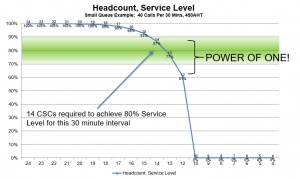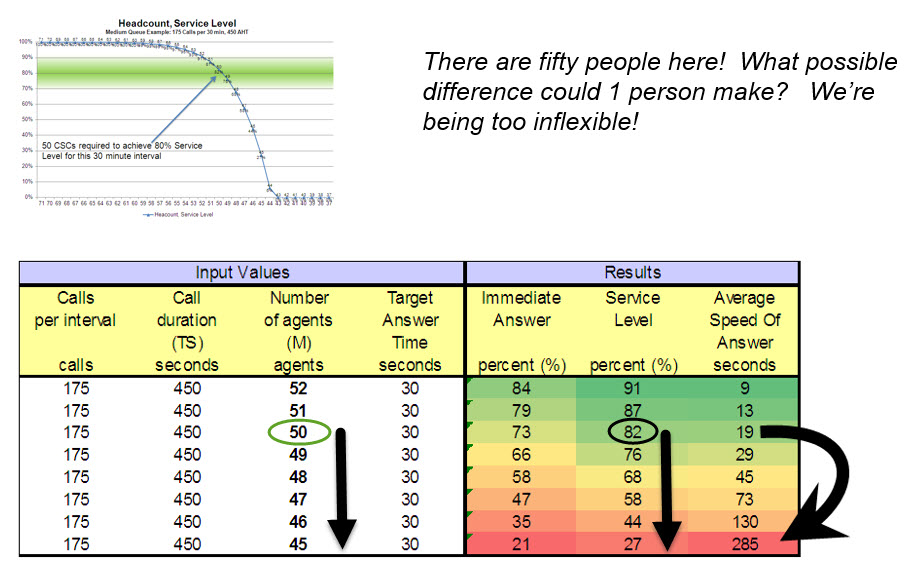Difference between revisions of "Power of One"
| (One intermediate revision by the same user not shown) | |||
| Line 24: | Line 24: | ||
==How significant is the impact?== | ==How significant is the impact?== | ||
| − | If we examine a queue requiring 50 people to staff, | + | If we examine a queue requiring 50 people to staff, using a demand interval which requires 175 calls with an AHT of 450 seconds, we see we'd need 50 reps to achieve an 80% of calls answered within 30 seconds. In this scenario, we would achieve an 82% service level, illustrated below. If we lose just a single resource, we see with 49 agents, the service level will drop to 76%, and continues to drop rapidly as 2, 3 or more agents are not staffed and ready to take the next call. |
| − | [[image:pow2.jpg|Impact to SL & ASA]] | + | In addition, the average speed of answer grows dramatically. If the queue was staffed missing 5 agents, the average speed of answer would grow by almost 5x, growing from 19 seconds to 285 seconds: |
| + | |||
| + | [[image:pow2.jpg|Impact to SL & ASA]] | ||
| + | |||
| + | This is a static view based on 175 calls with an AHT of 450 seconds - but what if I want to model a different size queue or different service level objectives. Below is a tool for dynamically calculating for different size queues: | ||
=Shiny & R Studio= | =Shiny & R Studio= | ||
Latest revision as of 10:43, 26 April 2019
Contents
Achieving Service Level
The ROC and Intraday management teams in WFM strive to meet service level goals throughout every interval of the day, even when unexpected situations arise. The ROC applies intraday management tactics to mitigate unforeseen events such as frontline staff calling in sick, weather events, sudden technical troubles, or unexpectedly high call volumes. And while the ROC takes action to make adjustments to maintaining service level in the face of these events, the WFM teams rely on strong partnerships with call handling agents and supervisors to jointly execute recovery plans.
The "Power of One" was a book published originally by Penny Reynolds and the Call Center School in 2005. Within the book, there were a few short chapters on "Staffing for Speed" and "sharing the Workload". These concepts demonstrated the importance of everyone playing their role and being available to handle the next call and general adherence to schedule.
One of the strongest concepts in the "Power of One" stresses how in a queue of 50 people, the difference of just a single person can impact service level.
Why Service Level?
Service level is considered the call center industry standard performance metric.
By monitoring service level and adjusting staff levels by interval, a contact center operation can ensure it is operating at optimal efficiency when measuring availability to customers.
The power of the service level metric is derived by its sensitivity for interval level performance to alert to either poor customer performance or potential waste in over-staffing.
What do we mean by service level sensitivity?
WFM teams leverage software systems which use various statistical models, the most popular being Erlang-C, to predict the waiting time and staffing required to meet the service level objective.
Erlang-C expresses the probability that an arriving customer will be offered to a queue vs. being immediately answered.
For forecasting activities, the Erlang formula is used to determine the precise number of customer service representatives needed to staff a queue, based on a specified target probability of queuing, or service level.
For managing real-time operations, if a queue is overstaffed or understaffed by a single representative, the interval service level will alert operations to potential waste in expenses (overstaffed) or negative impact of availability to customers (understaffed).
How significant is the impact?
If we examine a queue requiring 50 people to staff, using a demand interval which requires 175 calls with an AHT of 450 seconds, we see we'd need 50 reps to achieve an 80% of calls answered within 30 seconds. In this scenario, we would achieve an 82% service level, illustrated below. If we lose just a single resource, we see with 49 agents, the service level will drop to 76%, and continues to drop rapidly as 2, 3 or more agents are not staffed and ready to take the next call.
In addition, the average speed of answer grows dramatically. If the queue was staffed missing 5 agents, the average speed of answer would grow by almost 5x, growing from 19 seconds to 285 seconds:
This is a static view based on 175 calls with an AHT of 450 seconds - but what if I want to model a different size queue or different service level objectives. Below is a tool for dynamically calculating for different size queues:
Shiny & R Studio
R Studio and Shinyapps allow dynamic visualization and working models, exposing to an online interface. In this example, we've created an online visualization of the "Power of One" - showing the importance of how losing (or gaining) a single call center rep can dramatically impact interval service level.


